Improving Road Safety with AI-Powered Traffic Sign Detection on Matrice
Nov 18, 2024
Following our exploration of lane detection, we now advance to traffic sign detection – a vital component in road safety and autonomous driving. In this new experiment, we aim to detect various traffic signs like speed limits, stop signs, and traffic lights. Using Matrice’s no-code platform, we’ll see how AI can further enhance vehicle awareness on the road by identifying crucial signage accurately.
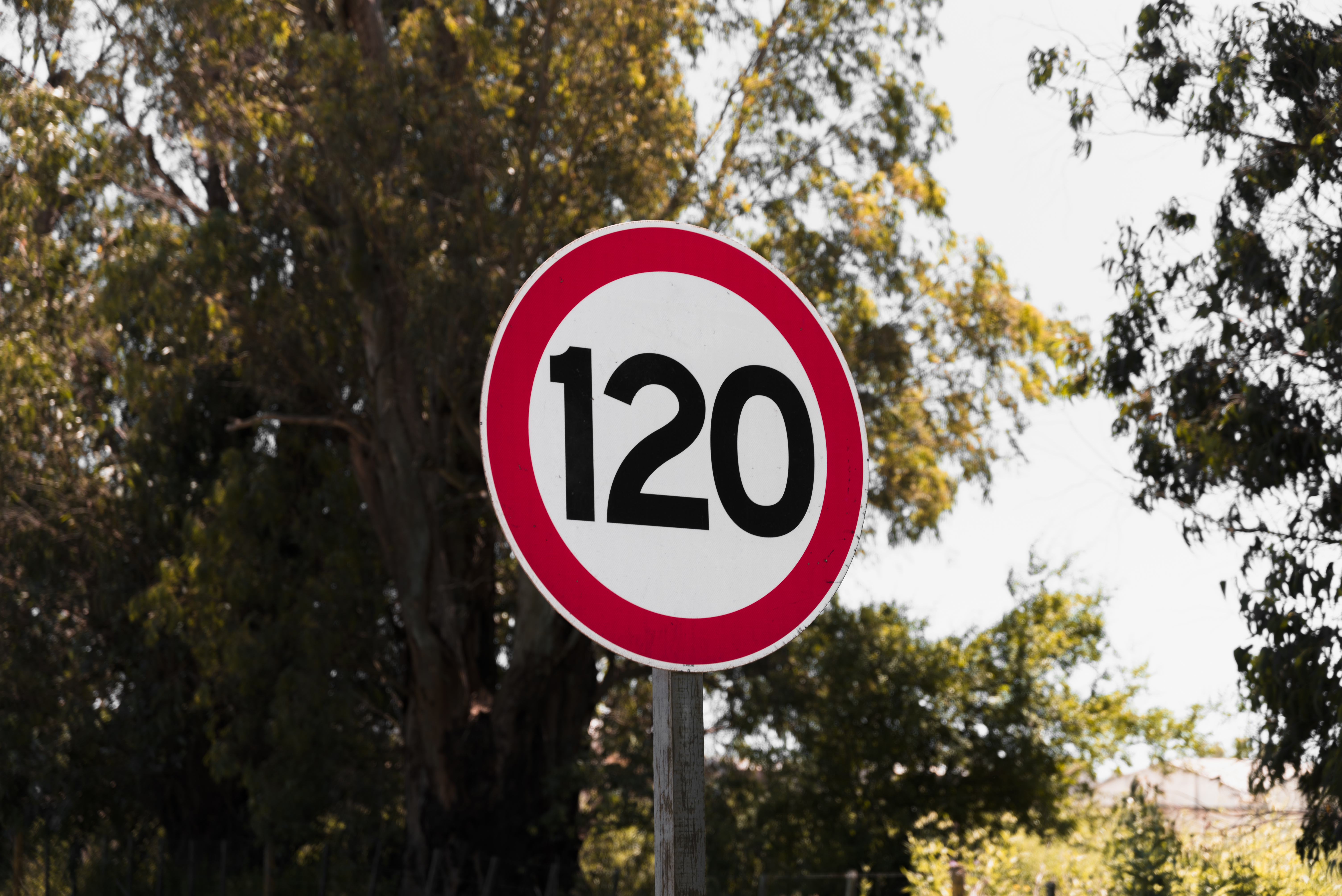
Understanding Computer Vision’s Role in Traffic Sign Detection
Building on computer vision’s contributions to lane detection, traffic sign detection goes a step further by identifying critical signals on the road, empowering vehicles to make safer decisions. Here’s how traffic sign detection contributes:
Recognizing Traffic Rules: Detecting signs like speed limits and stops helps in enforcing traffic laws, minimizing accidents due to speeding or missed signals.
Supporting Autonomous Decisions: Real-time recognition of traffic lights and pedestrian crossings assists autonomous vehicles in managing intersections and yielding to pedestrians.
Enhanced Driver Assistance: Alerts for upcoming signs ensure drivers are informed of upcoming road conditions or restrictions, reducing the risk of violations.
Why is Traffic Sign Detection Important?
Accurate traffic sign detection contributes significantly to road safety. Identifying and understanding road signs allows vehicles to respond appropriately to road regulations, ensuring safer navigation.
Increases Situational Awareness: Traffic sign detection keeps drivers informed of upcoming rules and conditions, such as speed limits and stop signs.
Supports ADAS: Advanced Driver Assistance Systems (ADAS) leverage traffic sign detection to provide timely alerts, improving reaction times.
Adapts to Road Changes: AI-driven systems adapt to dynamic environments, ensuring that both drivers and autonomous vehicles stay alert and make informed decisions.
The Solution: Leveraging Matrice’s No-Code Platform
Using Matrice’s platform, we can simplify the complex task of traffic sign detection. The platform’s intuitive interface allows users to set up, train, and deploy AI models without extensive coding, making it ideal for traffic sign detection in real-world scenarios.
To build upon your existing lane detection blog for traffic sign detection, we can follow a similar structure. Here’s an outline and suggested content to continue the blog series seamlessly: Enhancing Road Safety with AI-Driven Traffic Sign Detection: A Step Forward with Matrice
Following our exploration of lane detection, we now advance to traffic sign detection – a vital component in road safety and autonomous driving. In this new experiment, we aim to detect various traffic signs like speed limits, stop signs, and traffic lights. Using Matrice’s no-code platform, we’ll see how AI can further enhance vehicle awareness on the road by identifying crucial signage accurately.
Understanding Computer Vision’s Role in Traffic Sign Detection
Building on computer vision’s contributions to lane detection, traffic sign detection goes a step further by identifying critical signals on the road, empowering vehicles to make safer decisions. Here’s how traffic sign detection contributes:
Recognizing Traffic Rules: Detecting signs like speed limits and stops helps in enforcing traffic laws, minimizing accidents due to speeding or missed signals.
Supporting Autonomous Decisions: Real-time recognition of traffic lights and pedestrian crossings assists autonomous vehicles in managing intersections and yielding to pedestrians.
Enhanced Driver Assistance: Alerts for upcoming signs ensure drivers are informed of upcoming road conditions or restrictions, reducing the risk of violations.
Why is Traffic Sign Detection Important?
Accurate traffic sign detection contributes significantly to road safety. Identifying and understanding road signs allows vehicles to respond appropriately to road regulations, ensuring safer navigation.
Increases Situational Awareness: Traffic sign detection keeps drivers informed of upcoming rules and conditions, such as speed limits and stop signs.
Supports ADAS: Advanced Driver Assistance Systems (ADAS) leverage traffic sign detection to provide timely alerts, improving reaction times.
Adapts to Road Changes: AI-driven systems adapt to dynamic environments, ensuring that both drivers and autonomous vehicles stay alert and make informed decisions.
Challenges in Traditional Traffic Sign Detection
Traffic sign detection is not without challenges. Traditional methods often struggle with:
Sign Variability: Different colors, shapes, and lighting can affect detection accuracy.
Weather Conditions: Rain or snow can obscure signs, leading to misinterpretations.
Sign Obstruction: Signs partially blocked by foliage or vehicles pose a detection challenge.
Sign Deterioration: Faded or damaged signs require robust detection techniques to avoid errors.
The Solution: Leveraging Matrice’s No-Code Platform
Using Matrice’s platform, we can simplify the complex task of traffic sign detection. The platform’s intuitive interface allows users to set up, train, and deploy AI models without extensive coding, making it ideal for traffic sign detection in real-world scenarios. Step-by-Step Guide to Traffic Sign Detection with Matrice
Similar to our approach in lane detection, we will go through the stages of preparing, training, evaluating, and deploying our traffic sign detection model on Matrice’s platform.
Dataset Import
Annotation
Training and Model Evaluation
Model Deployment
Step 1: Importing the Dataset
For traffic sign detection, we need a dataset with diverse sign images. Importing into Matrice is straightforward, whether using a zip folder or cloud storage link. Matrice will organize the images, making it easy to navigate and prepare for the next steps.
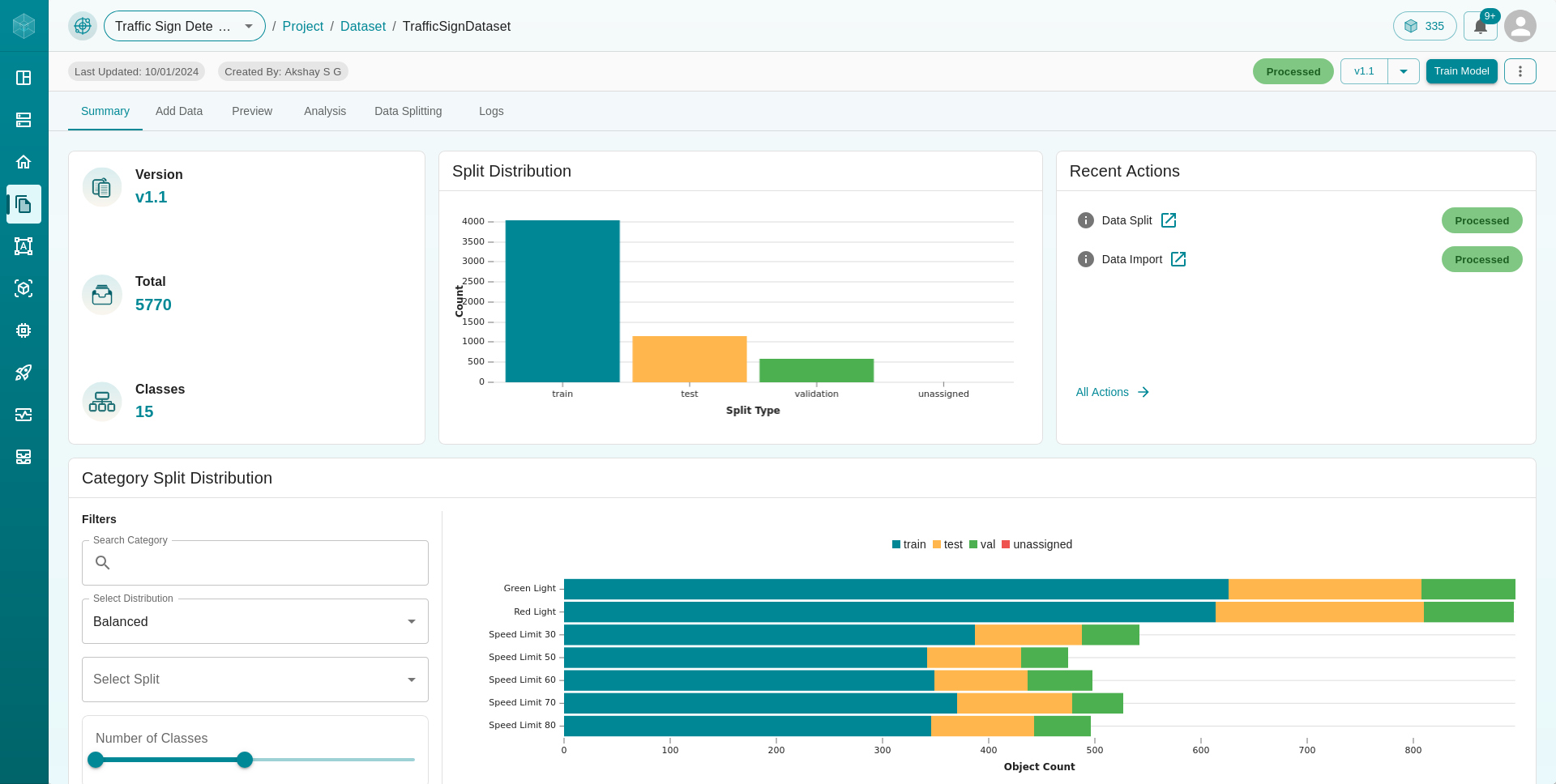
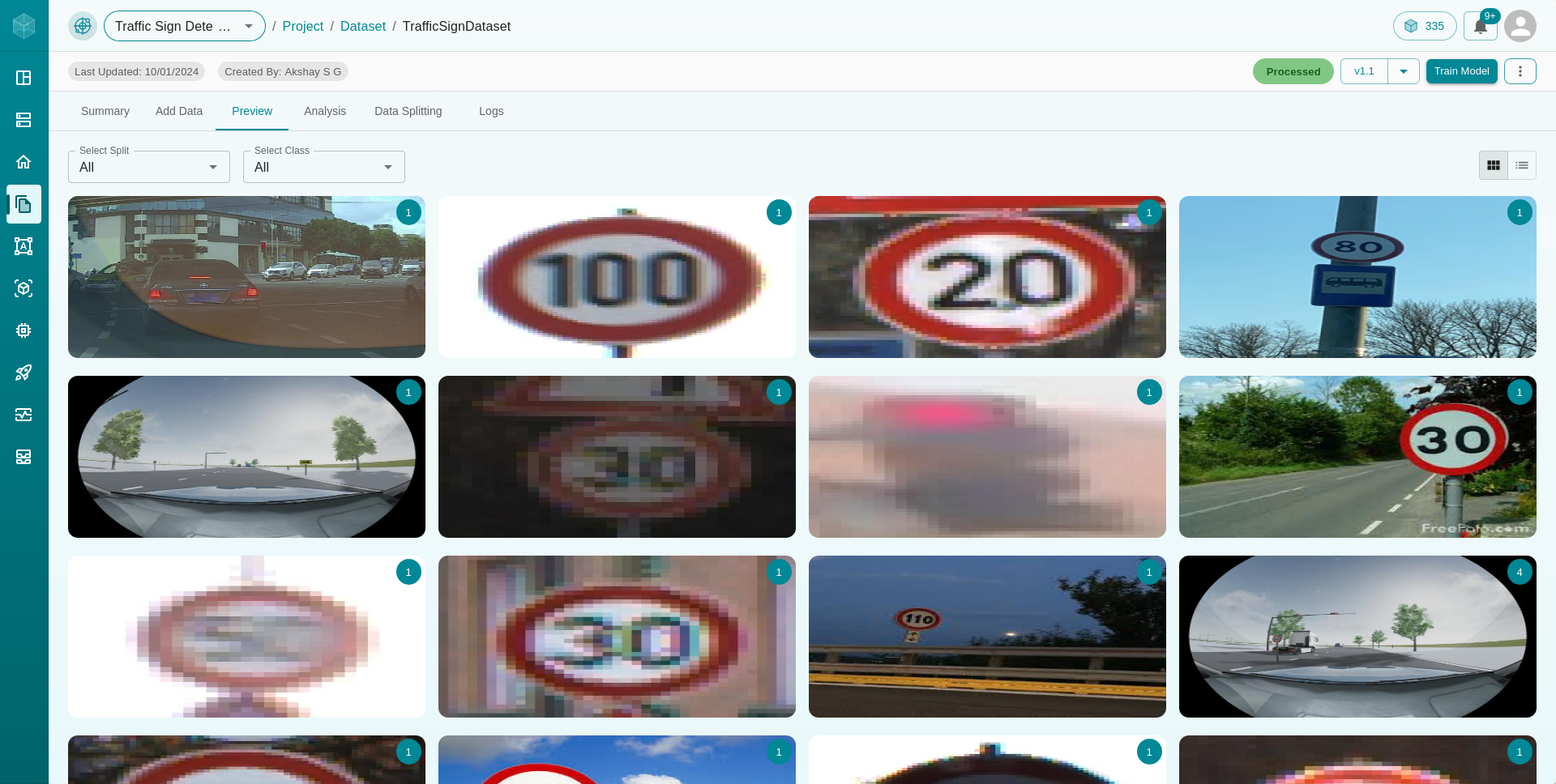
Step 2: Annotation
In Matrice’s annotation tool, label each type of traffic sign, such as speed limits, stop signs, and traffic lights. Matrice’s platform ensures quick and accurate annotation, crucial for enhancing detection precision.
Step 3: Training
Once annotations are ready, we can train the model. Matrice’s platform offers various state-of-the-art models to select from, optimized for high-accuracy detection across a range of signs and environments. Real-time feedback on loss and accuracy aids in fine-tuning model parameters.
Model Performance Comparison
Evaluating our traffic sign detection model, the following table details its performance on test and validation datasets:
Category |
Precision |
Recall |
||
|---|---|---|---|---|
Validation |
Test |
Validation |
Test |
|
All |
0.972 |
0.982 |
0.95 |
0.947 |
Red Light |
0.883 |
0.914 |
0.781 |
0.731 |
Speed Limit 10 |
0.975 |
0.982 |
0.988 |
0.988 |
Speed Limit 100 |
0.991 |
0.995 |
0.988 |
0.966 |
Speed Limit 110 |
0.919 |
0.995 |
0.933 |
0.885 |
Speed Limit 120 |
0.993 |
0.99 |
0.98 |
0.988 |
Speed Limit 20 |
0.988 |
0.991 |
0.988 |
0.988 |
Speed Limit 30 |
0.988 |
0.988 |
0.98 |
0.976 |
Speed Limit 40 |
0.961 |
0.989 |
0.971 |
0.953 |
Speed Limit 50 |
0.977 |
0.985 |
0.968 |
0.942 |
Speed Limit 60 |
0.987 |
0.988 |
0.933 |
0.974 |
Speed Limit 70 |
0.988 |
0.988 |
0.946 |
0.988 |
Speed Limit 80 |
0.961 |
0.999 |
0.98 |
0.989 |
Speed Limit 90 |
0.988 |
0.937 |
0.826 |
0.858 |
Stop |
0.978 |
0.986 |
0.988 |
0.989 |
Performance Insights
Stop and Speed Limit Signs: High precision and recall indicate the model’s reliability in detecting frequently encountered signs, even in variable conditions.
Traffic Lights: Good accuracy in both red and green light detection demonstrates the model’s effectiveness in signal recognition.
Yield Signs: Slightly lower recall suggests further data could improve performance on less common signs.
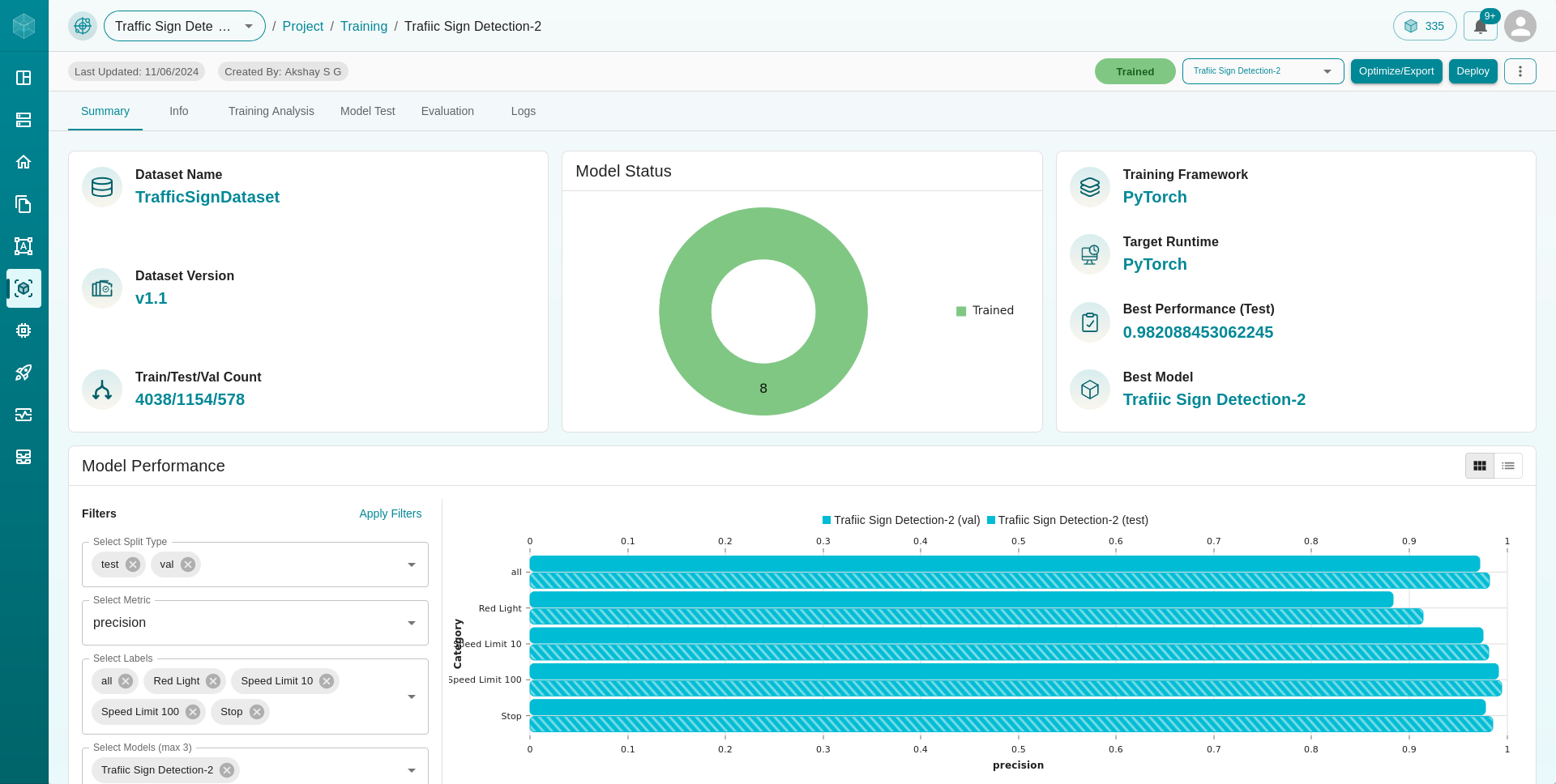
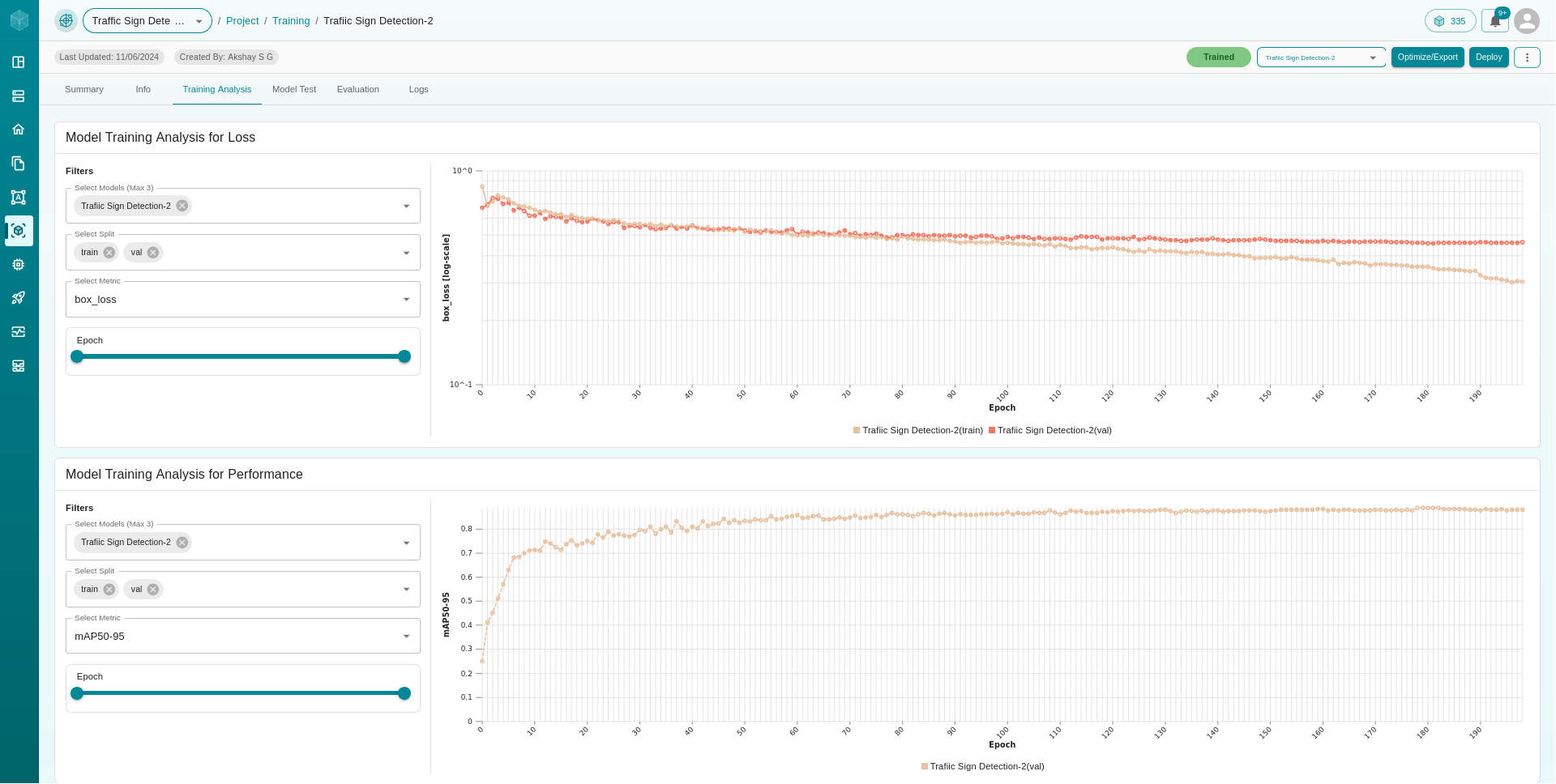
Step 4: Deployment
Once trained, deploying the traffic sign detection model on Matrice is simple. The platform’s deployment dashboard facilitates easy cloud hosting, enabling seamless integration into larger systems and allowing real-time testing of the model’s effectiveness on the road.
With the deployment dashboard, monitor your model’s performance, control access, and even scale deployment as needed. Integration with multiple programming languages ensures flexibility for developers incorporating traffic sign detection into larger applications.
Conclusion
With Matrice’s no-code platform, implementing traffic sign detection becomes an efficient, straightforward process. As we continue to expand road safety solutions, Matrice’s platform remains a powerful tool for computer vision applications, aiding in safer, more informed driving experiences.
Think CV, Think Matrice
Experience 40% faster deployment and slash development costs by 80%